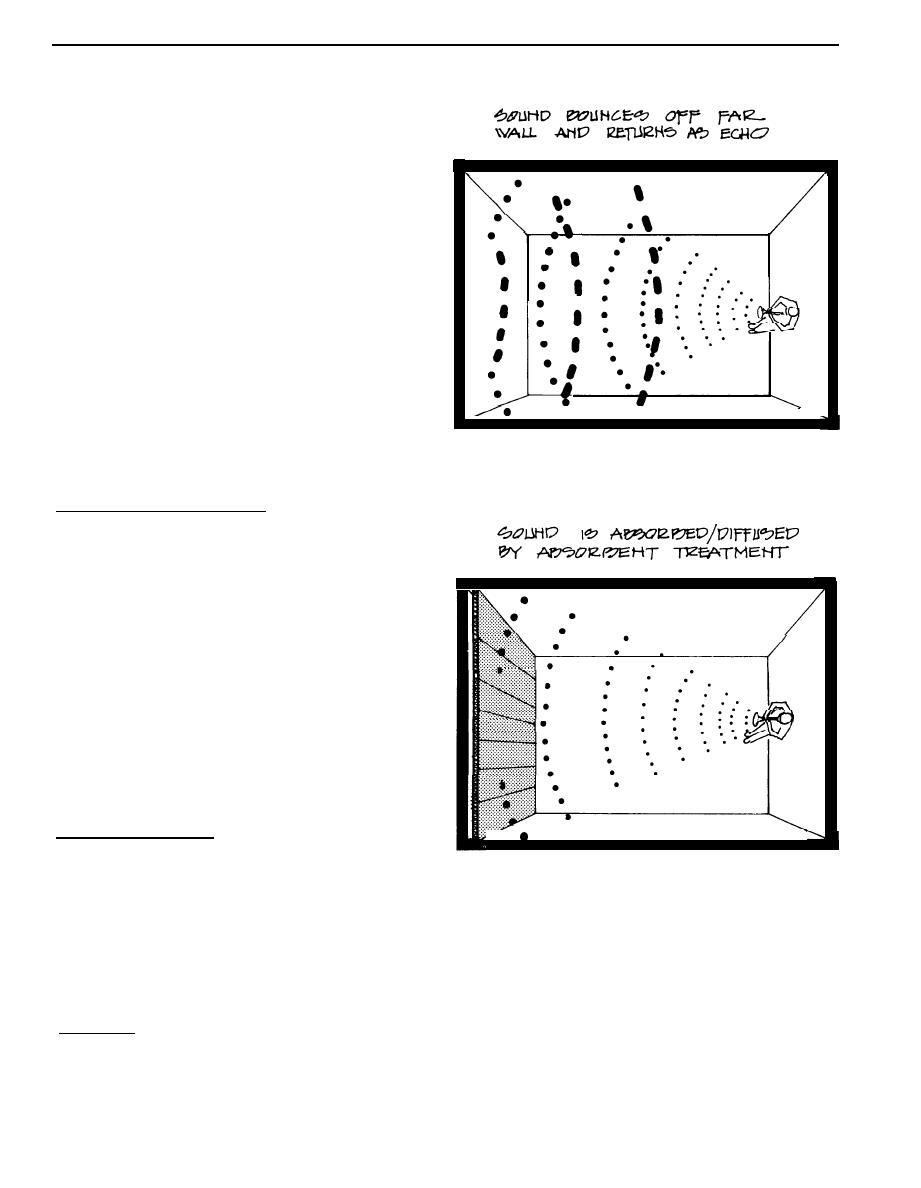
DG-1110-3-119
Design Guide: Band Training Facilities
General Design Programming
March 1983
of the room, which can be controlled by design. In essence,
every doubling of absorption reduces the sound level by
3 decibels, but also shortens the reverberation time* by a
factor of two. Since excessive loudness is a major prob-
lem in band practice and rehearsal rooms, liberal amounts
of absorptive treatments are recommended--most
typically, on the ceiling and the walls. The resultant (short)
reverberation times, implying "dead" acoustics, are far
preferable to a "live" but very loud sound. See Paragraph
5-4 for specifics on sound-absorbing materials.
A corollary means of reducing loudness is to increase the
room size well beyond the minimum required to accom-
modate the occupants. This will create larger surfaces that
can be treated (more absorption) and make the sound
travel longer distances before being reflected back to the
musicians (weaker reflections). For economic reasons,
increased size is most often to be found in increased height.
Therefore, ample volume is recommended--ceiling
heights of 18 to 30 feet for Main Rehearsal, 15 to 20 feet
for Large Group Practice, and 12 to 15 for Small Group
Practice. Individual Practice Rooms need not be as high:
ten to twelve feet is suggested, but 8 or 9 feet is often
acceptable; and like the larger rooms, they should contain
liberal areas of absorptive finishes.
2. Clarity and Communication. Abundant absorption,
as recommended for loudness and reverberation control,
automatically assures a fair degree of clarity. Sounds, once
made, stop quickly and do not compound into a state of
acoustic confusion. This helps the learning process for which
training facilities are built, but stands in contrast to con-
cert halls (which are much larger) where reverberation is
an asset.
In the Group Practice and smaller music rooms there is sel-
dom any difficulty in the players hearing each other. The
spaces are still relatively small and sound is reflected from
player to player, even off the nominally absorptive surfaces
(no material is totally absorptive), However, intra-group
communication in the Main Rehearsal Room, where dis-
tances are greater and the sound of one's own section tends
to dominate, is often lacking. The preferred solution is
to make the (high) ceiling partially reflective--to design a
pattern of reflective "islands" into an otherwise absorp-
tive ceiling (see 4.2.F.2 for detailed requirements).
3. Unwanted Effects. Adherence to the preceding
guidelines does not guarantee acoustical excellence, It
Figure 3-15. Treatment of Echoes
can be marred by one of several effects, the most com-
mon of which are: (a) discrete echoes off distant surfaces;
(b) flutter echo--a ringing sensation due to a pattern of
avoidance of parallel, reflective surfaces; and splaying
repetitive reflections along the same path; (c) focusing;
or treatment of these surfaces with absorptive materials;
and (d) standing waves-- a booming at specific, low
(c) avoidance of concave shapes including curved walls,
frequencies.
vaults, domes, etc.; (d) avoidance of principal room dimen-
The preventive measures to deal with these unwanted effects
sions (length, width, height) that are equal to or multiples
of each other (see Figures 3-15 and 3-16). The last
are, respectively: (a) absorptive finishes, especially on
problem -- standing waves--hardly affects the Main
distant walls, more than 30 feet from the sound source; (b)
Rehearsal Room, whose inherently large dimensions are
unlikely to support standing waves within the frequency
*Reverberation time is defined as the time it takes for the sound
range of interest.
energy density to decrease to one-millionth of its initial value; in
--
In addition to the problems and solutions discussed above,
other words, it is time during which, after the source has stopped,
the sound level decreases by 60 decibels.
the design of any music room should be such as to encour-
3-14


 Previous Page
Previous Page
